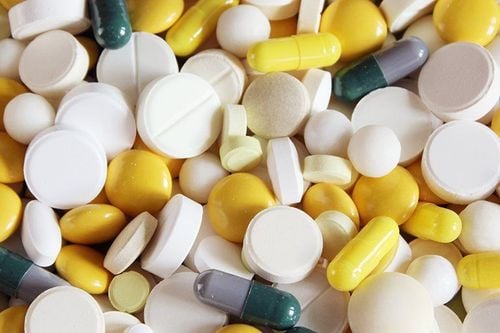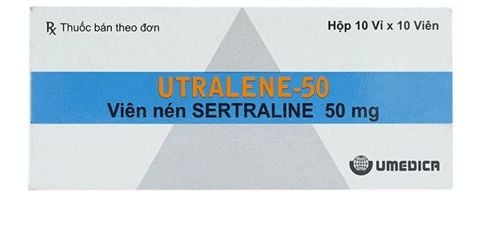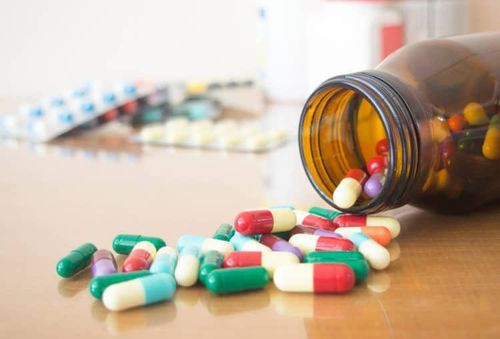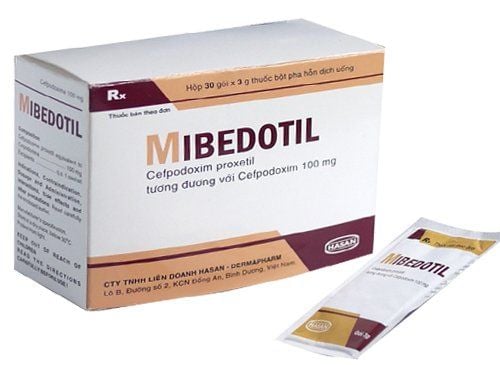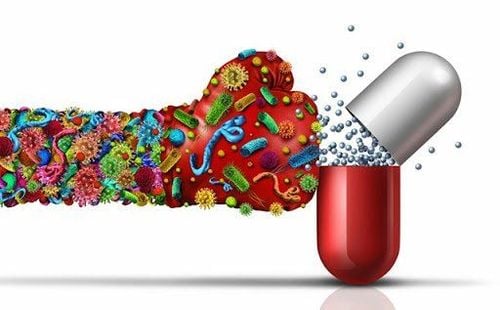This is an automatically translated article.
Cefurobiotic 500 has antibacterial effect with the main ingredient is cefuroxime 500mg and some other excipients. Let's learn the information in the following article to understand more about Cefurobiotic 500.
1. What is Cefurobiotic 500?
Cefurobiotic 500 has the main ingredient is Cefuroxim, belongs to the 2nd generation Cephalosporin antibiotic group, is prepared in the form of film-coated tablets, content 500mg.
Cefuroxime is an antibiotic used to treat infections caused by susceptible strains of bacteria. Second-generation cephalosporins have enhanced activity against gram-negative bacteria compared with first-generation cephalosporins but retain some activity against gram-positive bacteria. They are also more resistant to beta-lactamases.
Cephalosporins are bactericidal (kills bacteria) and work in a similar way to penicillins. They bind to and block the action of enzymes responsible for making peptidoglycan - thought to be an important component of bacterial cell walls. They are called broad-spectrum antibiotics because they are effective against many types of bacteria.
2. Uses of Cefurobiotic 500
2.1 Indications of the drug Cefurobiotic 500 Respiratory tract infections
Treatment of acute maxillary sinusitis caused by susceptible S. pneumoniae or H. influenzae (only strains that do not produce β-lactamase). Treatment of bacterial infections secondary to acute bronchitis caused by susceptible S. pneumoniae, H. influenzae (only non-β-lactamase producing strains) or H. parainfluenzae (non-β-lactamase producing strains only). Treatment of acute exacerbations of chronic bronchitis caused by susceptible S. pneumoniae, H. influenzae (non-β-lactamase producing strains only), or H. parainfluenzae (non-β-lactamase producing strains only). Parenteral therapy for lower respiratory tract infections (including pneumonia) caused by susceptible S. pneumoniae, S. aureus (including penicillinase-producing strains), S. pyogenes (streptococci) group A β hemolytic), H. influenzae (including ampicillin-resistant strains), Escherichia coli, or Klebsiella. Acute otitis media (AOM)
Treatment of AOM caused by Streptococcus pneumoniae, Haemophilus influenzae (including β-lactamase producing strains), Moraxella catarrhalis (including β-lactamase producing strains) or S. Pyogenes
Inflammation pharyngitis and tonsillitis Treatment of pharyngitis and tonsillitis caused by S. pyogenes (group A hemolytic streptococcus). Generally effective in eradicating S. pyogenes from the nasopharynx;
Skin and skin structure infections Oral treatment for uncomplicated skin and skin structure infections caused by susceptible S. aureus (including β-lactamase producing strains) or S. pyogenes .
Urinary tract infections (UTIs) Oral treatment for uncomplicated UTIs caused by susceptible E. coli or K. pneumoniae.
Gonorrhea and other genital infections Has been used orally or by injection to treat uncomplicated gonorrhea of the urethra, cervix, or rectum caused by susceptible Neisseria gonorrhoeae
Lyme disease Article Early stage Lyme disease is characterized by migratory erythema.
2.2 Contraindication of the drug Cefurobiotic 500 Do not use the drug in patients who are allergic or have a history of allergy to the Cephalosporin group of antibiotics, or to any of the excipients of the drug
Caution when using the drug Cefurobiotic 500 Prolonged antibiotic therapy alters the normal flora of the colon and may allow Clostridium difficile overgrowth. C. difficile infection (CDI) and C. difficile colitis and diarrhea (CDAD; also known as antibiotic-associated diarrhea and colitis or pseudomembranous colitis) have been reported with nearly all including anti-infectives.
Consider CDAD if diarrhea develops during or after treatment and manage accordingly. Take a careful history because CDAD can occur as late as 2 months or longer after stopping anti-infective therapy.
If CDAD is suspected or confirmed, discontinue the medication immediately. Initiate appropriate supportive therapy (eg, fluid and electrolyte management, protein supplementation), anti-infective therapy directed at C. difficile (eg, metronidazole, vancomycin), and surgical evaluation according to clinical indications.
Although cefuroxime rarely causes changes in renal function, it is still advisable to check the kidneys during treatment with cefuroxime, especially in critically ill patients receiving the maximum dose. Caution should be exercised when co-administering potent diuretics with patients with potent diuretics, as there may be adverse effects on renal function.
Long-term use of cefuroxime may cause overgrowth of non-susceptible strains. Patients should be carefully monitored. If severe superinfection occurs during treatment, the drug must be discontinued.
Cefuroxime is excreted in breast milk at low concentrations. This concentration is not expected to have an effect on the nursing infant, but should be concerned if the infant has diarrhea, thrush and rash.
2.3 Cefurobiotic 500 side effects Signs of an allergic reaction, such as a rash; hives ; itchy; red, swollen, blistering, or peeling skin with or without fever; wheeze; chest or throat tightness; difficulty breathing, swallowing; unusual hoarseness; or swelling of the mouth, face, lips, tongue, or throat.
Any unexplained bruising or bleeding. Inability to urinate or change the amount of urine. Feeling very tired or weak. Seizures Vaginal itching or discharge. Hearing loss. Eosinophilia, decrease in hemoglobin and hematocrit, neutropenia, decrease in hemoglobin concentration Increase in AST, transient increase in ALT, transient increase in liver enzyme levels Diarrhea is common with antibiotics. Rarely, a serious form called C-related diarrhea (CDAD) may occur. Sometimes, this has led to a deadly bowel problem (colitis). CDAD can occur during or several months after taking antibiotics. Call your doctor at once if you have stomach pain, cramping, or very loose, watery, or bloody stools. Check with your doctor before treating diarrhea.
3. How to use Cefurobiotic 500 effectively
3.1. How to use cefurbiotic 500 Read carefully the instructions for use before use Take the drug with boiled water to cool, Should be taken after meals Do not bite, chew, crush the tablet 3.2. Dosage of the drug cefurbiotic 500 Pharyngitis, tonsillitis or maxillary sinusitis caused by susceptible bacteria: Take 250 mg every 12 hours. In acute exacerbations of chronic bronchitis or acute bronchitis with secondary infections or in uncomplicated skin and soft tissue infections: 250 mg or 500 mg orally every 12 hours. In uncomplicated urinary tract infections: Oral 125 mg or 250 mg every 12 hours. Uncomplicated cervical or urethral gonorrhea or uncomplicated rectal gonorrhea in women: A single dose of 1 g, should be taken with 1g probenecid. New Lyme disease: Take 500 mg, twice a day, for 20 days. Note:
The usual course of treatment is 7 days, it can be used for up to 10 days, but it needs to be prescribed by a doctor This drug is only used under a doctor's prescription. The above dosage is for reference only. The specific dose depends on the condition and the progression of the disease. To get the right dose, you need to consult your doctor or healthcare professional. Above is the information about Cefurobiotic 500, you need to read the instructions carefully before using it to get the most effective use of the drug.
Please dial HOTLINE for more information or register for an appointment HERE. Download MyVinmec app to make appointments faster and to manage your bookings easily.




